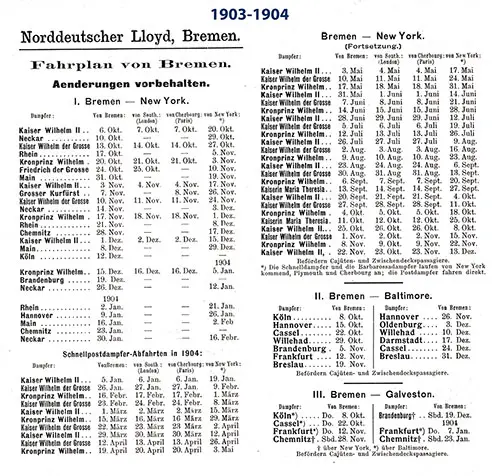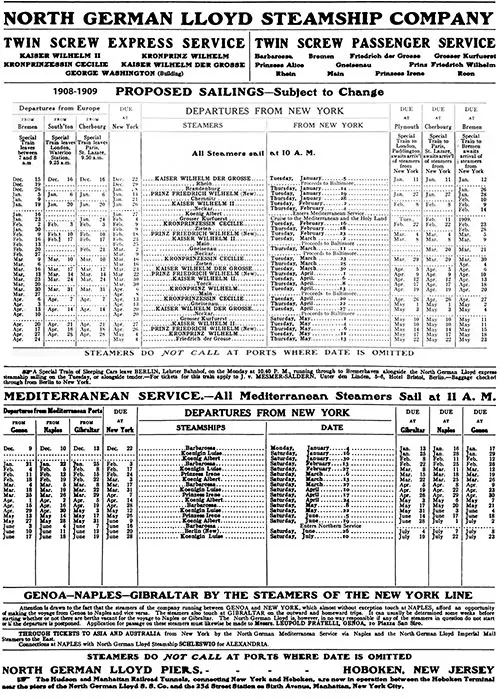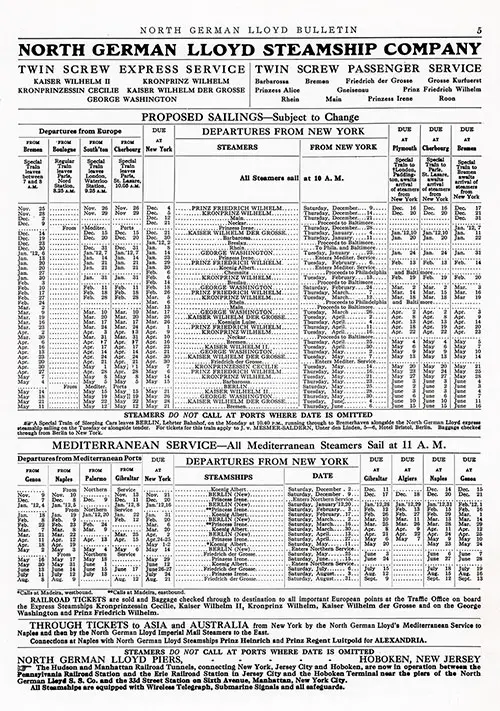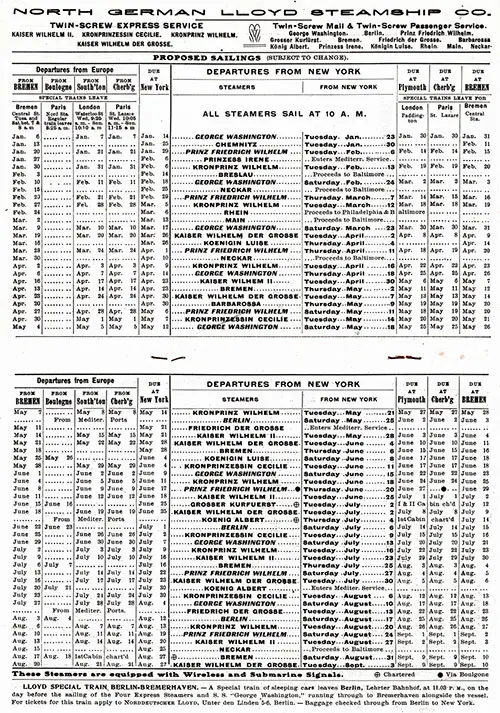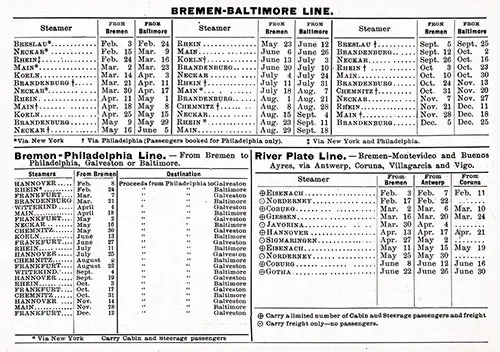SS Chemnitz Archival Collection
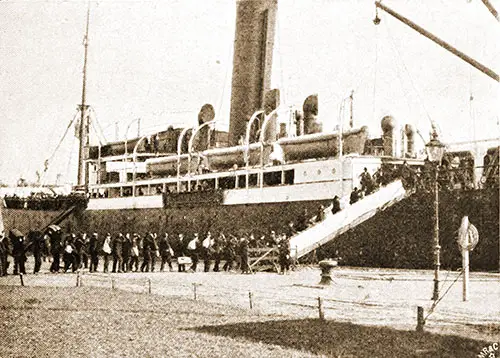
Steerage Passengers Embarkation onto the SS Chemitz of the Norddeutscher Lloyd circa 1903. | GGA Image ID # 17d4ea28b2
Chemnitz (1901) North German Lloyd
Built by J. C. Tecklenborg, Geestemunde, Germany. Tonnage: 7,543. Dimensions: 428' x 54' (453' o.l.). Twin-screw, 13 knots. Triple expansion engines. Two masts and one funnel. Service: Mainly in Europe-Baltimore. Sale: Acquired by Ellerman Wilson Line after World War I. Fate: Sold to Dutch shipbreakers in November 1923. Sister ships: Cassel, Brandenburg and Breslau.
Return to Content Links

1902-09-18 SS Chemnitz Passenger List
Steamship Line: Norddeutscher Lloyd (North German Lloyd)
Class of Passengers: Cabin
Date of Departure: 18 September 1902
Route: Bremen to Baltimore and Galveston
Commander: Captain J. Jantzen
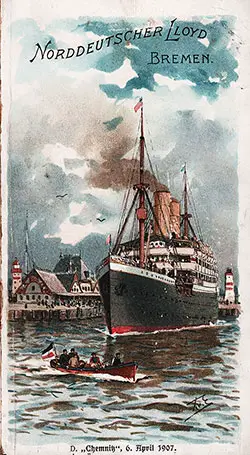
1907-04-06 SS Chemnitz Passenger List
Steamship Line: North German Lloyd / Norddeutscher Lloyd
Class of Passengers: Cabin
Date of Departure: 6 April 1907
Route: Bremen to New York
Commander: Captain E. Zachariae
Return to Content Links
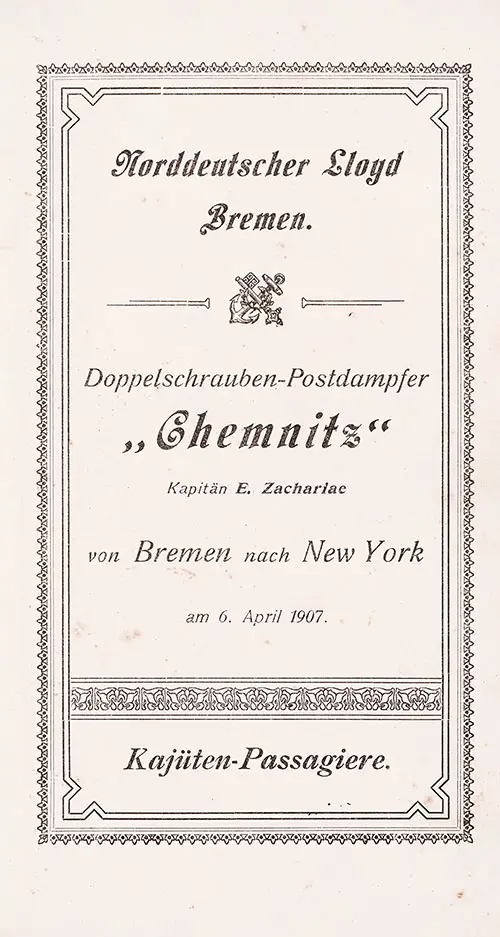
Title Page, SS Chemnitz Cabin Passenger List, 6 April 1907. | GGA Image ID # 20e57e8be6
Return to Content Links
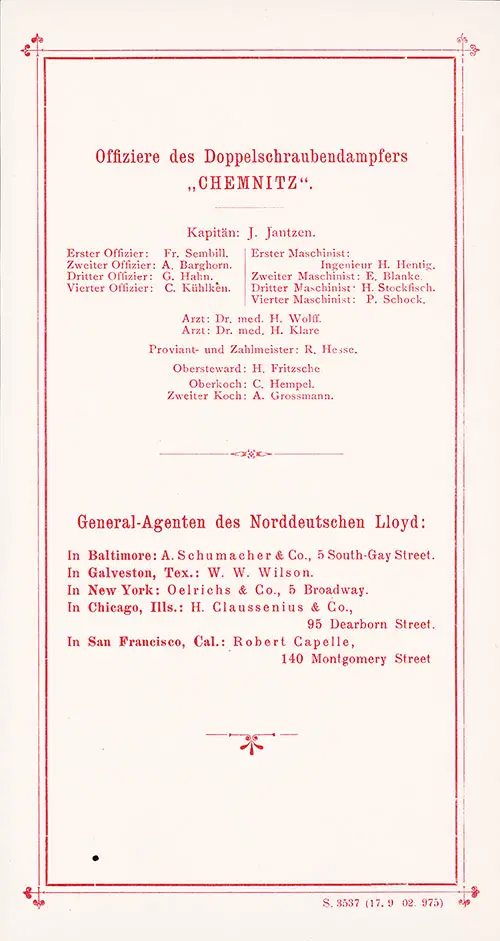
Senior Officers and Staff and US General Agents for Norddeutscher Lloyd, SS Chemnitz Passenger List, 18 September 1902. | GGA Image ID # 1f50965c1f
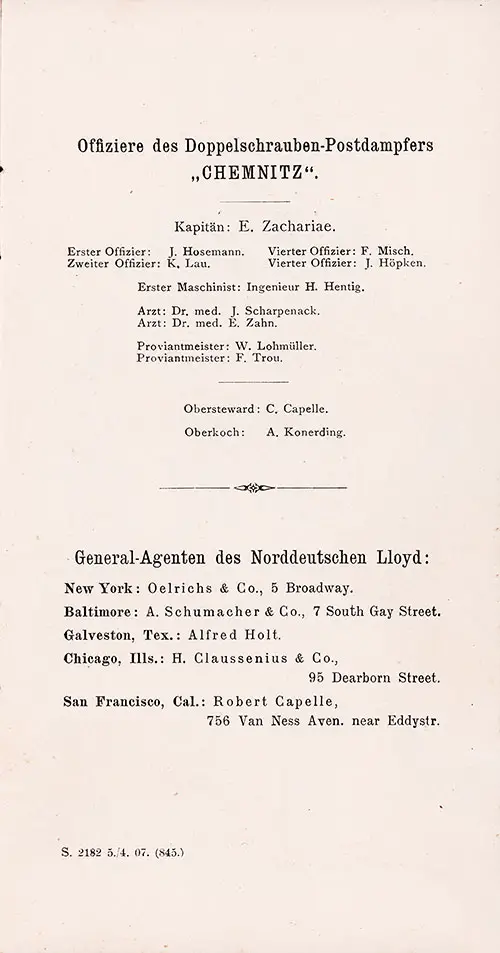
Senior Officers and Staff and US General Agents for Norddeutscher Lloyd, SS Chemnitz Passenger List, 6 April 1907. | GGA Image ID # 1f761c1b84
Return to Content Links
Sailing Schedule, Bremen-New York, Bremen-Baltimore, and Bremen-Galveston, from 6 October 1903 to 13 December 1904. Ships Included the Brandenburg, Breslau, Cassel, Chemnitz, Darmstadt, Frankfurt, Friedrich der Grosse, Grosser Kurfürst, Hannover, Kaiser Wilhelm der Grosse, Kaiser Wilhelm II, Köln, Kronprinz Wilhelm, Main, Neckar, Oldenburg, Rhein, and Willehad. SS Kaiser Wilhelm II Passenger List, 6 October 1903. | GGA Image ID # 1ebbf5ff3c. Click to View Larger Image.
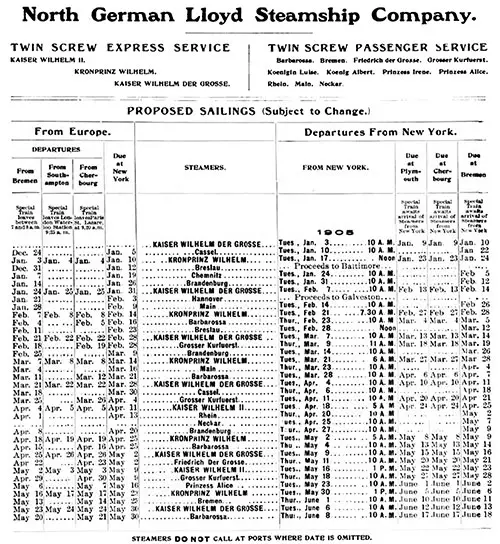
Sailing Schedule, Bremen-Southampton-Cherbourg-New York and New York-Plymouth-Cherbourg-Bremen, from 24 December 1904 to 18 June 1905. Ships Included the Barbarossa, Brandenburg, Breslau, Cassel, Chemnitz, Grosser Kurfurst, Hannover, Kaiser Wilhelm der Grosse, Kaiser Wilhelm II, Kronprinz Wilhelm, Main, Neckar, Prinzess Alice, and Rhein. North German Lloyd Bulletin, January 1905. | GGA Image ID # 1eeab8ebe7
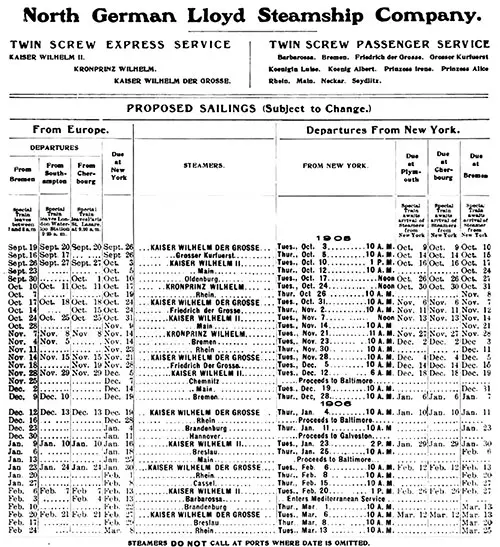
Sailing Schedule, Bremen-Southampton-Cherbourg-New York and New York-Plymouth-Cherbourg-Bremen, from 19 September 1905 to 25 March 1906. Ships Included the Barbarossa, Brandenburg, Bremen, Breslau, Cassel, Chemnitz, Friedrich der Gorsse, Grosser Kurfurst, Hannover, Kaiser Wilhelm der Gorsse, Kaiser Wilhelm II, Kronprinz Wilhelm, Main, Oldenburg, and Rhein. North German Lloyd Bulletin, October 1905. | GGA Image ID # 1eeb04fb9e
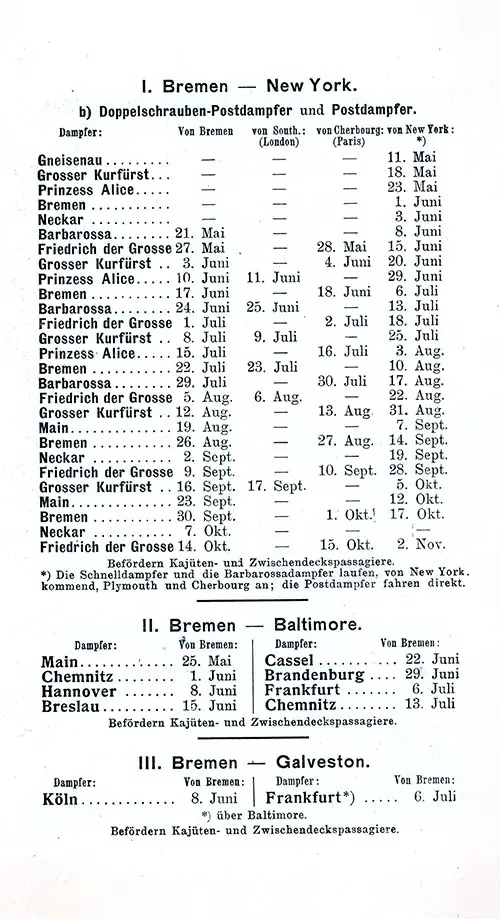
Sailing Schedule, Bremen-New York, Bremen-Baltimore, and Bremen-Galveston, from 11 May 1905 to 2 November 1905. Ships Included the Barbarossa, Brandenburg, Bremen, Breslau, Cassel, Chemnitz, Frankfurt, Friedrich der Grosse, Gneisenau, Grosser Kurfürst, Hannover, Köln, Main, Neckar, and Prinzess Alice. SS Kaiser Wilhelm der Grosse First and Second Class Passenger List, 23 May 1905. | GGA Image ID # 21087c14bc
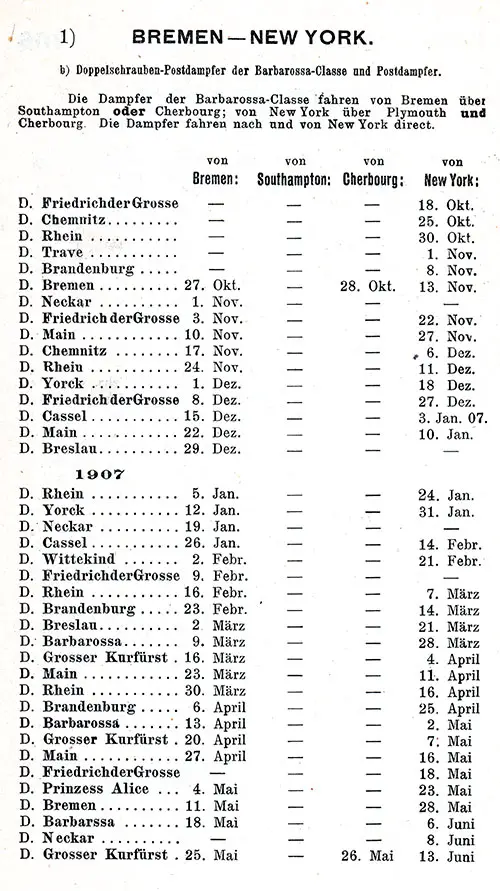
Sailing Schedule, Bremen-Southampton-Cherbourg-New York, from 18 October 1906 to 13 June 1907. Ships Included the Barbarossa, Brandenburg, Bremen, Breslau, Cassel, Chemnitz, Friedrich der Grosse, Grosser Kurfürst, Main, Neckar, Prinzess Alice, Rhein, Trave, Wittekind, and Yorck. SS Bremen Passenger List, 27 October 1906. | GGA Image ID # 213e1cc54d
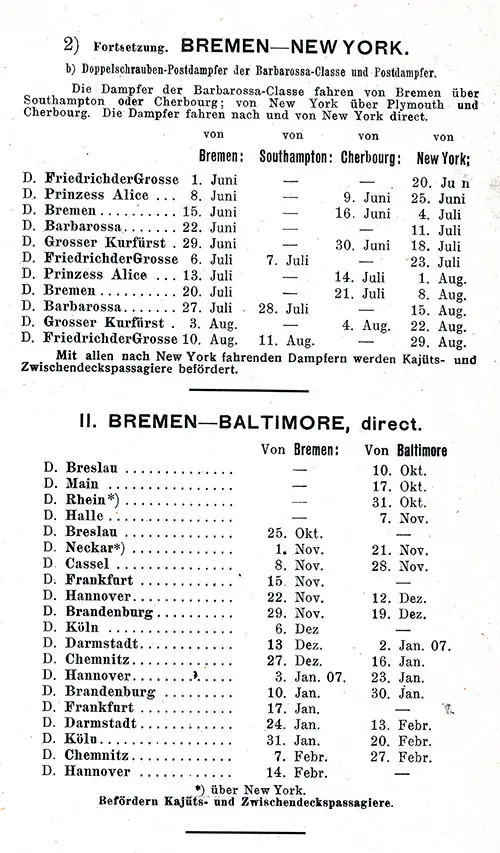
Sailing Schedule, Bremen-New York and Bremen to Baltimore, From 10 October 1906 to 29 August 1907. (Note: Bremen-New York Is for 1907, a Continuation From Previous Schedule). Ships Included the Barbarossa, Brandenburg, Bremen, Breslau, Cassel, Chemnitz, Darmstadt, Frankfort, Friedrich der Grosse, Grosser Kurfürst, Halle, Hannover, Köln, Main, Neckar, Prinzess Alice, and Rhein. SS Bremen Passenger List, 27 October 1906. | GGA Image ID # 213e5f2762
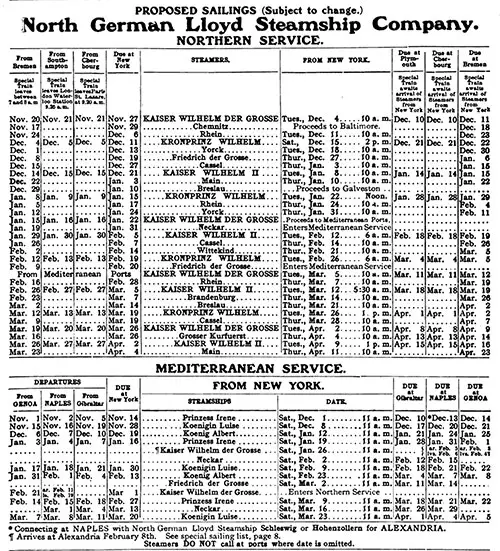
Sailing Schedule, Bremen-Southampton-Cherbourg-New York and New York-Plymouth-Cherbourg-Bremen. Mediterranean Service: Genoa-Naples-Gibraltar-New York and New York-Gibraltar-Naples-Genoa, from 1 November 1906 to 23 April 1907. Ships Included the Brandenburg, Breslau, Cassel, Chemnitz, Friedrich der Grosse, Grosser Kurfurst, Kaiser Wilhelm der Grosse, Kaiser Wilhelm II, Kronprinz Wilhelm, Main, Neckar, Rhein, Wittekind, and Yorck. North German Lloyd Bulletin, December 1906. | GGA Image ID # 1eebb9208d

Sailing Schedule, Bremen-Southampton-Cherbourg-New York, Barbarossa-Class Twin-Screw Mail Steamer and Mail Steamer, from 28 March 1907 to 14 November 1907. Ships Included the Barbarossa, Brandenburg, Bremen, Breslau, Chemnitz, Frankfurt, Friedrich der Grosse, Grosser Kurfürst, Main, Prinzess Alice, Rhein, Roon, Trave, and Würzburg. SS Chemnitz Passenger List, 6 April 1907. | GGA Image ID # 1f764bc518. The Steamers of the Barbarossa Class Go from Bremen via Southampton or Cherbourg; From New York via Plymouth and Cherbourg—the Mail Steamers Run To and from New York Direct. All Steamers Bound for New York Carry Cabin and Steerage Passengers.
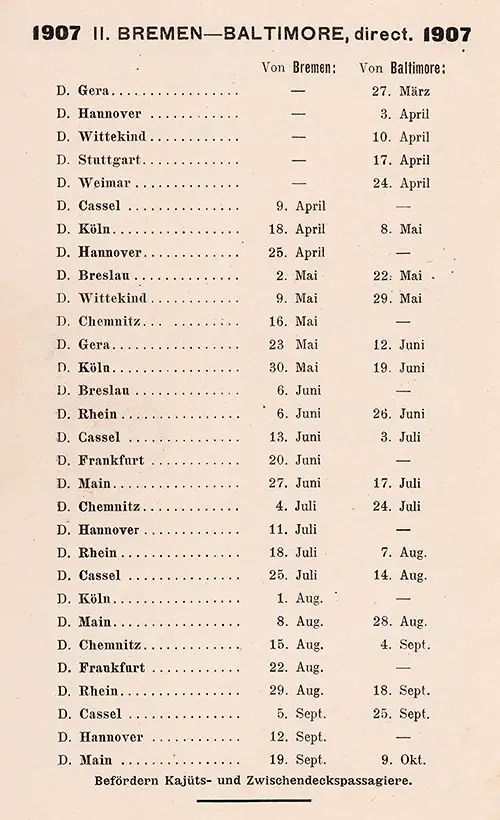
Sailing Schedule, Bremen-Baltimore (Direct), from 27 March 1907 to 9 October 1907. Ships Included the Breslau, Cassel, Chemnitz, Frankfurt, Gera, Hannover, Köln, Main, Rhein, Stuttgart, Weimar, and Wittekind. Ships Carry Cabin and Steerage Passengers. SS Chemnitz Passenger List, 6 April 1907. | GGA Image ID # 1f766813b3
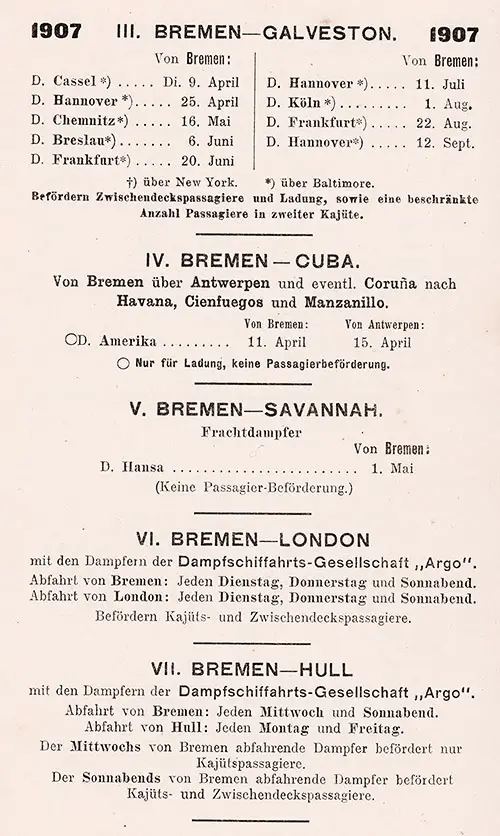
Sailing Schedule, Bremen-Galveston, Bremen-Cuba, Bremen-Savannah, Bremen-London, and Bremen-Hull, from 9 April 1907 to 12 September 1907. Ships Included the Amerika, Breslau, Cassel, Chemnitz, Frankfurt, Hannover, Hansa, and Köln. SS Chemnitz Passenger List, 6 April 1907. | GGA Image ID # 1f766f1fa7
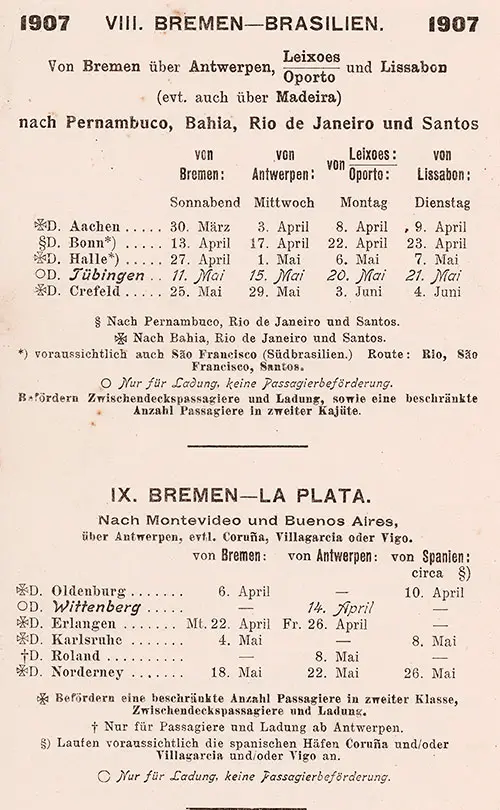
Sailing Schedule, Bremen-Brazil and Bremen-La Plata, from 30 March 1907 to 4 June 1907. Ships Included the Aachen, Bonn, Crefeld, Erlangen, Halle, Karlsruhe, Norderney, Oldenburg, Roland, Tübingen, and Wittenberg. SS Chemnitz Passenger List, 6 April 1907. | GGA Image ID # 1f768fc82f
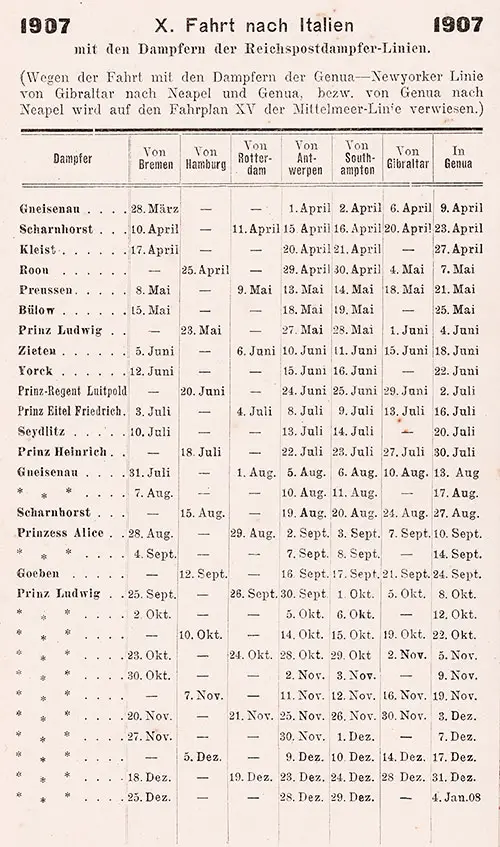
Sailing Schedule, Breman-Hamburg-Rotterdam-Antwerp-Southampton-Gibraltar-Genoa, from 28 March 1907 to 8 January 1908. Ships Included the Bülow, Gneisenau, Goeben, Kleist, Preussen, Prinz Eitel Friedrich, Prinz Heinrich, Prinz Ludwig, Prinz Regent Luitpold, Prinzess Alice, Roon, Scharnhorst, Seydlitz, Yorck, and Zieten. SS Chemnitz Passenger List, 6 April 1907. | GGA Image ID # 1f76a639e5
Sailing Schedule, Bremen-Southampton-Cherbourg-New York, New York-Plymouth-Cherbourg-Bremen, Genoa-Naples-Gibraltar-New York, and New York-Gibraltar-Naples-Genoa, from 9 December 1908 to 23 July 1909. Ships Included the Barbarossa, Berlin, Brandenburg, Chemnitz, Friedrich der Grosse, Gneisenau, Grosser Kurfurst, Kaiser Wilhelm der Grosse, Kaiser Wilhelm II, Koenig Albert, Koenigin Luise, Kronprinzessin Cicilie, Main, Neckar, Prinz Friedrich Wilhelm, Prinzess Irene, Rhein, Yorck, and Zieten. North German Lloyd Bulletin, January 1909. | GGA Image ID # 1f519dd3c6. Click to View Larger Image.
Proposed Sailings, Bremen-New York and New York-Mediterranean Services, from 10 November 1911 to 13 September 1912. Ships Included the Baarbarossa, Berlin, Bremen, Breslau, Chemnitz, George Washington, Kaiser Wilhelm der Grosse, Kaiser Wilhelm II, Koenig Albert, Koenigin Luise, Kronprinz Wilhelm, Main, Neckar, Prinz Friedrich Wilhelm, Prinzess Irene, and Rhein. North German Lloyd Bulletin, December 1911. | GGA Image ID # 1e304c62cd. Click to View Larger Image.
Sailing Schedule, Bremen-New York, from 6 January 1912 to 10 September 1912. Ships Included the Barbarossa, Berlin, Bremen, Breslau, Chemnitz, Friedrich der Grosse, George Washington, Grosser Kurfürst, Kaiser Wilhelm der Grosse, Kaiser Wilhelm II, König Albert, Königin Luise, Kronprinz Wilhelm, Kronprinzessin Cicilie, Main, Neckar, Prinz Friedrich Wilhelm, Prinzess Irene, and Rhein. SS Berlin First and Second Cabin Passenger List, 20 January 1912. | GGA Image ID # 20d7a7de48. Click to View Larger Image.
Sailing Schedule, Bremen-Baltimore Line, Bremen-Philadelphia Line, and the River Plate Line, from 3 February 1912 to 25 December 1912. Ships Included the Brandenburg, Breslau, Chemnitz, Coburg, Eisenach, Frankfurt, Giessen, Gotha, Hannover, Javorina, Köln, Main, Neckar, Norderney, Rhein, Sigmaringen, and Wittekind. SS Berlin First and Second Cabin Passenger List, 20 January 1912. | GGA Image ID # 20d81054a8. Click to View Larger Image.
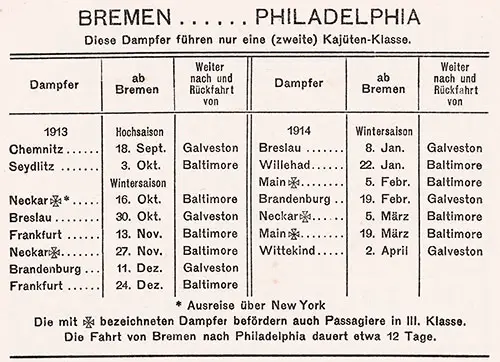
Sailing Schedule, Bremen-Philadelphia, from 18 September 1913 to 2 April 1914. Ships Included the Brandenburg, Breslau, Chemnitz, Frankfurt, Main, Neckar, Seydlitz, Willehad, and Wittekind. SS Grosser Kurfürst Passenger List, 8 November 1913. | GGA Image ID # 1f682ff461
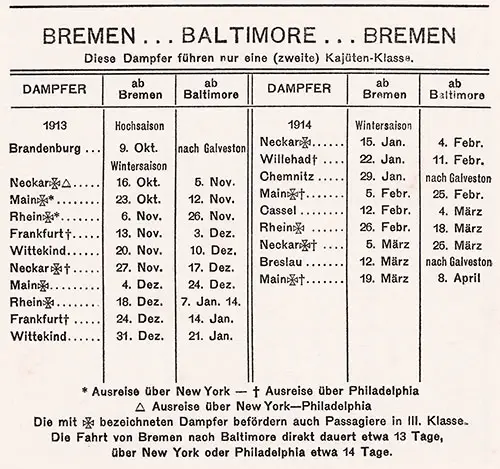
Sailing Schedule, Bremen-Baltimore-Bremen, from 9 October 1913 to 8 April 1914. Ships Included the Brandenburg, Breslau, Cassel, Chemnitz, Frankfurt, Main, Neckar, Rhein, Willehad, and Wittekind. SS Grosser Kurfürst Passenger List, 8 Novmeber 1913. | GGA Image ID # 1f6888ea56
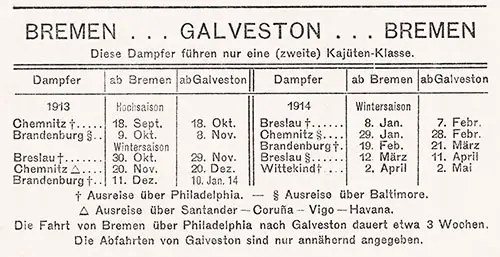
Sailing Schedule, Bremen-Galveston-Bremen, from 18 September 1913 to 2 May 1914. Ships Included the Brandenburg, Breslau, Chemnitz, and Wittekind. SS Grosser Kurfürst Passenger List, 8 Novmeber 1913. | GGA Image ID # 1f68fd7e3d
Return to Content Links
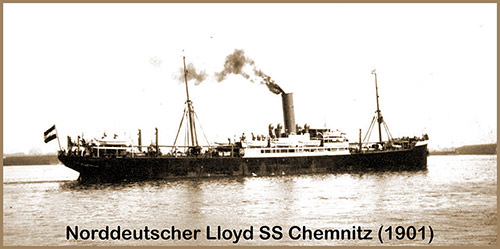
The SS Chemnitz (1901) of the Norddeutscher Lloyd Bremen. The Ship was Built for the Emigrant Trade, Capable of Carrying Almost 2,000 Immigrants in Steerage. | GGA Image ID # 1d30cbb9eb

Embrkation of Steerage Passengers onto the SS Chemnitz, 1903. | GGA Image ID # 20e5543d22
Return to Content Links
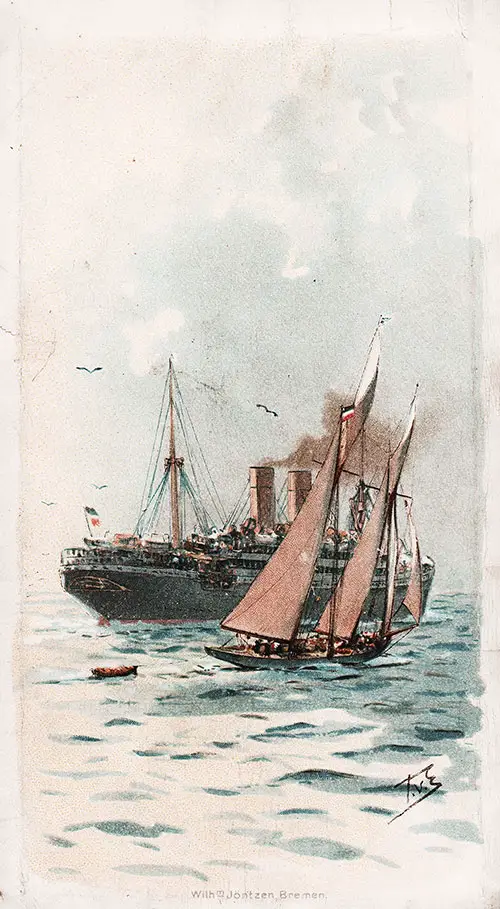
Back Cover, SS Chemnitz Cabin Passenger List, 6 April 1907. | GGA Image ID # 20e556e735
Return to Content Links
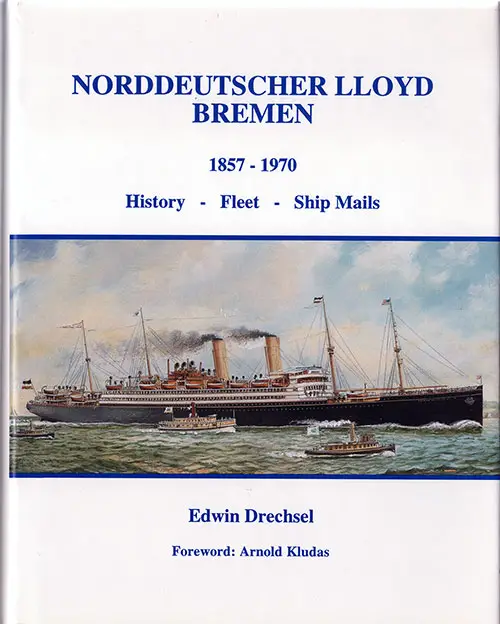
Norddeutscher Lloyd Bremen 1857-1970, Volume One, History -- Fleet -- Ship Mails
🌍 Transatlantic Titans: The Rise of Norddeutscher Lloyd and the Transformation of Ocean Travel (1857–1918)
Norddeutscher Lloyd, Bremen, 1857–1970, Volume 1 by Edwin Drechsel is a meticulously researched chronicle of the origins and golden age of the Norddeutscher Lloyd (NDL), one of the most important steamship lines in global maritime history.
The book covers:
- The founding of NDL in 1857 by Hermann Henrich Meier and Eduard Crüsemann
- The transition from sail to steam, paddle to screw propulsion
- The increasing demand for transatlantic mail and passenger service
- The NDL’s competition with British lines for speed, prestige, and the Blue Riband
- The line’s crucial role in transporting millions of emigrants to North America
- Its involvement in global mail and freight services
- The impact of World War I on German shipping and commerce
Volume 1 concludes just before or during the war years that halted NDL’s rapid rise.

Norddeutscher Lloyd Bremen 1857-1970, Volume Two, History -- Fleet -- Ship Mails
Winds of Change: Norddeutscher Lloyd and the Final Era of Ocean Travel (1920–1970)
The second volume of Edwin Drechsel’s monumental work Norddeutscher Lloyd, Bremen, 1857–1970 picks up in the aftermath of World War I, tracing five tumultuous decades through:
🌊 Postwar decline and slow recovery
🚢 The interwar years and the Blue Riband triumph of the Bremen (1929)
📉 The Great Depression’s toll on ocean travel
🌍 The transformation of global shipping under the shadow of WWII
🧱 Postwar reconstruction and the decline of passenger liners
📦 The pivot to container freight and the 1970 merger with HAPAG
Drechsel, drawing on his personal ties (his father was a North German Lloyd captain), maritime journalism background, and deep expertise in ship mails and German liner history, delivers a book that is both richly detailed and profoundly human.
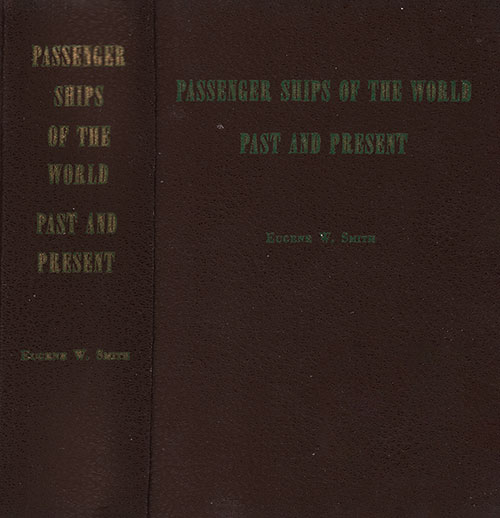
Passenger Ships of the World - 1963
🎓 “A Global Voyage Through Steamship History for Historians, Genealogists, and Maritime Enthusiasts”
Eugene W. Smith’s Passenger Ships of the World – Past and Present (1963) is a masterfully curated encyclopedic reference that charts the rise, peak, and transformation of ocean-going passenger ships through nearly two centuries. Expanding upon his earlier Trans-Atlantic and Trans-Pacific works, Smith offers a global maritime panorama that includes ships serving the Americas, Africa, Europe, Asia, Australia, and Oceania, as well as Canal routes and California-Hawaii shuttle lines.
🧭 This book is an essential resource for:
- Maritime historians seeking design evolution and fleet data
- Genealogists tracing voyages and shipping lines
- Educators and students studying transoceanic migration and tourism
- Ship modelers, naval architects, and enthusiasts interested in dimensions, tonnage, and speed

The Wilson Line of Hull 1831-1981
The book traces the development of the Line under the Wilson family, with sections on ports of call, ships lost during both World Wars, wrecks, and ships in the news. Much of the book comprises a detailed fleet list, and the text is supported throughout by over 100 photographs and illustrations, some in color.
Return to Content Links
Praise For the Cape Route - 1912
Interviewed at Cape Town, the Captain of the North German Lloyd liner Chemnitz said he preferred the Cape route to the Suez Canal route. There was a considerable saving in money and no loss of time as he could make the trip to Australia via the Cape as quickly as he could by the Suez route.
The Canal route meant calling at ten or twelve other ports for passengers and cargo. In contrast, the passage to the Cape was a direct one after leaving Madeira What a steamer has to pay for coming through the Canal works out at 10s per head for all passengers, men, women, and children and 7s 6d per ton on her gross tonnage This heavy charge against a steamer is saved by using the Cape route.
The question was put, why has the North German Lloyd Company not always used the Cape route? The answer was that the Australian trade in the past has yet to be of a character to permit steamers leaving Bremen and Antwerp with sufficient cargo and passengers to warrant a straight trip via the Cape.
Now that immigration is being encouraged by the Commonwealth and trade with Australia is more developed, steamers can leave the European ports sufficiently laden to make the Cape route advantageous to owners and shippers alike. Captains and officers of all vessels that formerly went through the Canal prefer the Cape route.
"Praise for the Cape Route," in South Africa, London: Winchester House, 19 October 1912, p. 142.
Return to Content Links
The Story of the SS Chemnitz -1923
The SS Chemnitz was a steamship of the Norddeutscher Lloyd, a German shipping company that operated from 1857 until 1970. The Chemnitz was built in 1898 by the AG Weser shipyard in Bremen, Germany, and was launched in January of that year. It was named after the city of Chemnitz in Saxony, Germany.
The Chemnitz was a passenger and cargo ship designed to carry passengers and freight on its voyages. It had a length of 138 meters (453 feet), a beam of 16.5 meters (54 feet), and a depth of 11.4 meters (37 feet). It had a gross tonnage of 7,527 tons and could reach a maximum speed of 14 knots (26 kilometers per hour).
The Chemnitz was used on several routes during its service with the Norddeutscher Lloyd. It initially operated on the company's transatlantic service between Bremen, Germany, and New York City, carrying passengers and cargo across the Atlantic. It also served on the company's service between Bremen and Baltimore, Maryland.
During World War I, the German military used the Chemnitz as a troop transport ship, and it saw action in the Mediterranean and the Black Sea. After the war, it was returned to the Norddeutscher Lloyd and refurbished before being put back into service on its transatlantic and Baltimore routes.
In 1923, the Chemnitz was scrapped by Dutch shipbreakers.
As for the number of passengers and crew members, the ship could carry, that would depend on the specific voyage and its intended use. However, as a passenger ship, the Chemnitz could have taken on several hundred passengers, along with a crew of several dozen.
Return to Content Links

